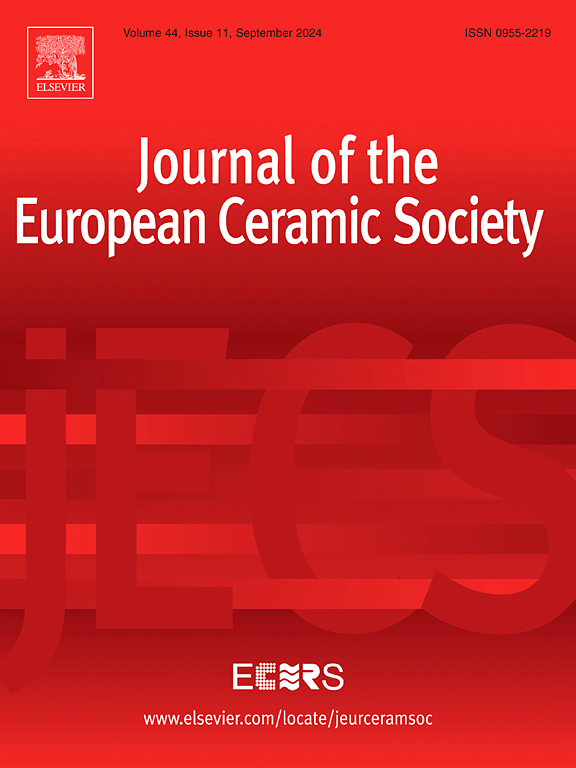RMI法制备涂层基集成C/(Hf, Zr, Ti)C-(Ti, Zr, Hf)3SiC2-SiC复合材料的组织与性能
IF 5.8
2区 材料科学
Q1 MATERIALS SCIENCE, CERAMICS
Journal of The European Ceramic Society
Pub Date : 2025-06-27
DOI:10.1016/j.jeurceramsoc.2025.117642
引用次数: 0
摘要
以HfSi2-ZrSi2-TiSi2杂化合金为材料,采用RMI工艺制备了C/(Hf, Zr, Ti)C-(Ti, Zr, Hf)3SiC2-SiC复合材料,并具有Hf-Zr-Ti基原位涂层。研究了复合材料的显微组织、力学性能和烧蚀性能。以(Hf, Zr, Ti)C-(Hf, Zr, Ti)Si2为主要成分的原位涂层与基体不断结合。在衬底中,边缘有较多的富Hf (Hf, Zr, Ti)C,内部有较多的富Ti (Ti, Zr, Hf)3SiC2和SiC。在层状(Ti, Zr, Hf)3SiC2的作用下,复合材料的抗折强度为225 ± 5.93 MPa,断裂韧性为11 ± 0.85 MPa·m1/2。烧蚀60 s后,复合材料的线性烧蚀速率为−2.13 ± 0.91 μm/s,质量烧蚀速率为−0.97 ± 0.01 mg/s。玻璃状SiO2促进(Hf, Zr, Ti)O2烧结和液态TiO2修复缺陷,使材料具有优异的抗烧蚀性能。本文章由计算机程序翻译,如有差异,请以英文原文为准。
Microstructure and properties of coating-matrix integrated C/(Hf, Zr, Ti)C-(Ti, Zr, Hf)3SiC2-SiC composites prepared via RMI process
C/(Hf, Zr, Ti)C-(Ti, Zr, Hf)3SiC2-SiC composites with Hf-Zr-Ti based in-situ coatings were prepared by RMI process utilizing HfSi2-ZrSi2-TiSi2 hybrid alloy. The microstructure, mechanical properties, and ablation performance of the composites were investigated. The in-situ coating with (Hf, Zr, Ti)C-(Hf, Zr, Ti)Si2 as main components was continuously integrated with the matrix. In the substrate, there were more Hf-rich (Hf, Zr, Ti)C in the marginal region and more Ti-rich (Ti, Zr, Hf)3SiC2 and SiC in the interior. The flexural strength of the composites was 225 ± 5.93 MPa and fracture toughness was 11 ± 0.85 MPa·m1/2 under the effect of lamellar (Ti, Zr, Hf)3SiC2. After ablation for 60 s, the linear and mass ablation rates of the composites were −2.13 ± 0.91 μm/s and −0.97 ± 0.01 mg/s, respectively. The outstanding ablation resistance was attributed to the glassy SiO2 promoting (Hf, Zr, Ti)O2 sintering and liquid TiO2 healing defects.
求助全文
通过发布文献求助,成功后即可免费获取论文全文。
去求助
来源期刊

Journal of The European Ceramic Society
工程技术-材料科学:硅酸盐
CiteScore
10.70
自引率
12.30%
发文量
863
审稿时长
35 days
期刊介绍:
The Journal of the European Ceramic Society publishes the results of original research and reviews relating to ceramic materials. Papers of either an experimental or theoretical character will be welcomed on a fully international basis. The emphasis is on novel generic science concerning the relationships between processing, microstructure and properties of polycrystalline ceramics consolidated at high temperature. Papers may relate to any of the conventional categories of ceramic: structural, functional, traditional or composite. The central objective is to sustain a high standard of research quality by means of appropriate reviewing procedures.
 求助内容:
求助内容: 应助结果提醒方式:
应助结果提醒方式:


